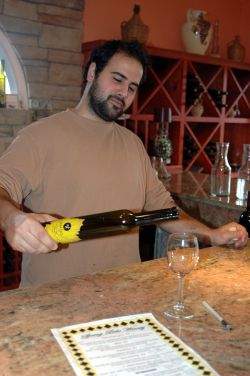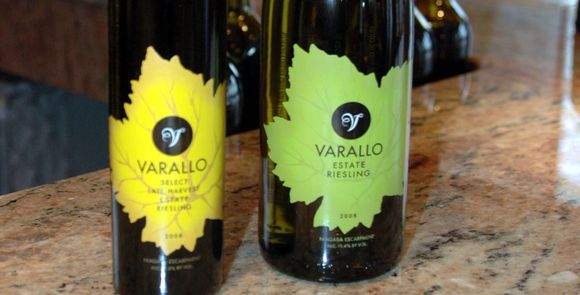By Julia Burke, Niagara Escarpment Correspondent
Riesling (in some form) shows up on nearly every wine list on the Niagara Wine Trail – after all, it is New York’s signature white grape. But for Spring Lake Winery, located just east of Lockport, riesling isn’t just a standby white grape. It’s the only variety planted on their eight acres.
The Varallo family, owners of Spring Lake, have been making wine for three generations, but it was only a few years ago that they decided to try their hands at growing grapes.
After researching the land and consulting with Finger Lakes and Ontario winemakers, they decided that their soil – a sandy, well-drained loam left by what was once a sand quarry – was best suited to riesling, so that’s what they planted, along with a few experimental rows of pinot noir.
 “It’s been quite a learning curve,” chuckles Dominic Varallo, who became winemaker and vineyard manager with no formal training and had to have a crash course in everything from trellis systems to tasting room service.
“It’s been quite a learning curve,” chuckles Dominic Varallo, who became winemaker and vineyard manager with no formal training and had to have a crash course in everything from trellis systems to tasting room service.
Of course, a single wine would make for a mighty short tasting, so Spring Lake supplements their riesling offerings with wine made at the winery from California grapes, mostly from Sonoma and Alexander Valley: merlot, cabernet sauvignon, chardonnay, and gewurztraminer. The Spring Lake brand name is used for the purchased fruit while “Varallo Vineyards” is reserved for estate wines – a smart way to separate the two and make sure the estate stuff gets special attention.
The California wines are all well-made and tasty; the merlot was earthy with a nice tannic grip and meaty spice, and the gewurz offered the most lusciously fruity nose I’ve ever experienced with this variety, oozing with tropical fruit and well-balanced at 2.5% RS.
Naturally, I was most excited about the 2008 Riesling and Late Harvest Riesling. The 2008, their first estate release, was flawed with signs of oxidation and a withered-spinach quality in the nose. Dominic foresees much improvement this year. “We had a lower yield this year, bigger clusters, a cleaner crop,” he says. I got to taste some juice from their 2009 harvest – October 16 this year – and was pleased to find good acidity and nice aromatics. Varallo does an arrested fermentation on his riesling, cooling it with a chiller. He plans to make a semi-dry Riesling this year using this method.
I asked Varallo what was it was going to take to make this area equal to Ontario in renown. He replied, “This!” and set his 2008 Late Harvest Riesling on the counter with pride. “We need to take advantage of this climate – we can’t be California. We can do this kind of thing here.”
Now I was interested – this one had a subtle nose of apricot and nectarine, with a nice finish of stewed orange peel and cranberry. Varallo tells me they harvested at 29 Brix and were able to make 398 cases of this Late Harvest. They sell it for $35 in the tasting room.
What’s the future of riesling in the Niagara region? There’s significant variation between the Niagara Escarpment itself, the northern region along Lake Ontario, and the sandy soil of the east, and I can’t wait to compare a riesling from each specific area in a blind tasting and see what differences are apparent.
Varallo’s pinot noir, incidentally, will be made into a rose – he hasn’t been thrilled with the results he’s seen and wants to focus solely on riesling. The only other grapes he would consider planting, he says, are gewurztraminer and cabernet franc.
Spring Lake Winery at Varallo Vineyards is definitely a winery to watch as their vines mature and they improve their winemaking practices – and cheers to them for making the decision to focus on a single varietal and take on the daunting task of perfecting it. I’m really looking forward to tasting what Dominic Varallo and his family have to offer in the next few years.

